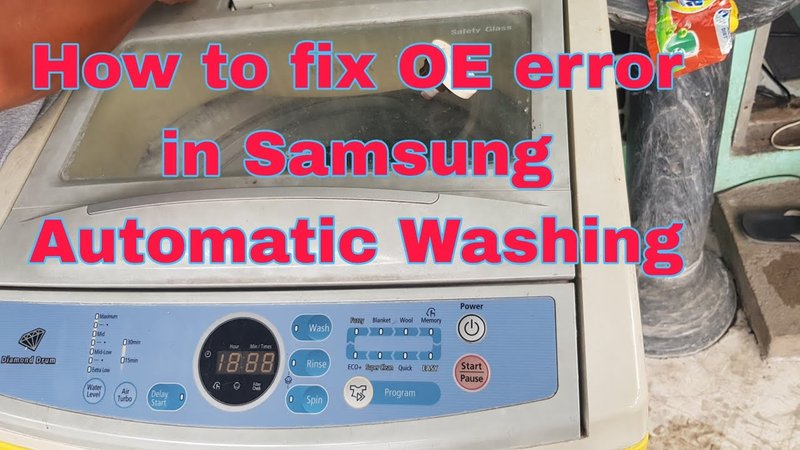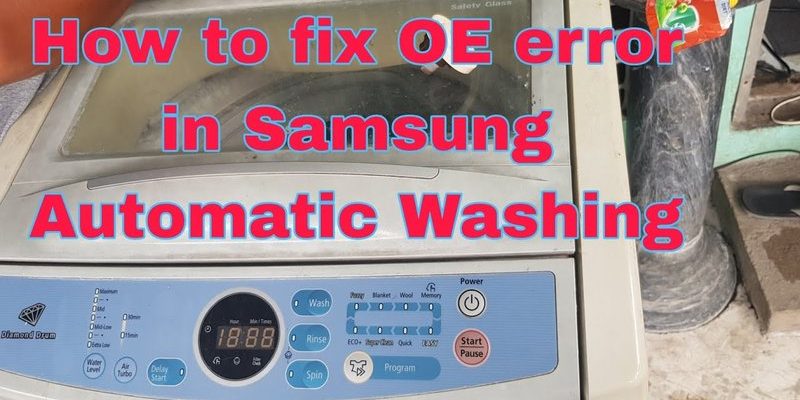
So, what exactly is this “OE” error? In simple terms, it usually indicates a problem with the draining mechanism of your washing machine. Imagine trying to pour water out of a bottle with the cap still on—it’s not going to be efficient, right? In our case, if the washing machine can’t drain properly, it shows the “OE” code as a way to say, “Hey, something’s not right here!” Luckily, with a bit of knowledge and some simple preventative measures, you can keep this pesky error at bay.
Understanding the “OE” Error Code
The “OE” error code is primarily related to drainage issues within your Samsung washing machine. Think of it as a signal that your machine is having trouble expelling water. This can be due to a variety of factors, such as a kinked drain hose, a clogged filter, or even a problem with the pump itself. Picture this scenario—if the hose is bent like a straw, the water struggles to flow, which can trigger the error.
Let’s dive deeper: first, the drain hose. This is the pathway the water uses to escape your machine. If it’s blocked or bent, it’s like trying to breathe through a straw that’s been squeezed in the middle—it’s challenging! Ensuring that the hose is straight and clear can prevent a lot of trouble. Similarly, a blocked or dirty filter can impede water flow. It’s like having a clogged sink; the water just won’t go down.
Next, consider the pump. The pump is your machine’s little helper that pushes the water out. If it’s malfunctioning, the machine might halt and throw the “OE” error. Imagine a bicycle pump; if it’s broken, it’s not going to push air effectively. In washing machines, the pump pushes water, and any issues here can lead to the dreaded error code.
Common Causes Behind the Error
One of the first culprits to look at when diagnosing the “OE” error is the drain hose. Over time, the hose can become twisted or even partially blocked by debris. It’s like having a clogged pipe at home—nothing is going to flow smoothly until the blockage is removed. Checking the hose regularly and ensuring it’s not twisted is a straightforward way to prevent problems.
Another common issue is the drain filter. The filter is designed to catch lint and other small particles, but it can become clogged over time. When this happens, it’s like trying to suck a thick milkshake through a tiny straw; the flow is restricted. Regularly cleaning the filter ensures that water can drain freely, preventing errors and keeping your machine in good health.
Finally, there’s the drain pump itself. If the pump is faulty, it may not effectively push out the water, leading to an error code. This is akin to a car engine that’s not firing correctly—it’s trying to work but can’t do its job properly. Regular maintenance checks can ensure the pump is functioning well, significantly reducing the likelihood of encountering the “OE” error.
Preventative Measures You Can Take
Preventing the “OE” error can be as simple as incorporating a few regular maintenance habits into your cleaning routine. First, make checking the drain hose a regular part of your laundry schedule. Ensure that it’s straight and free from any obstructions. Think of it as looking both ways before crossing the street—it’s a small step that ensures a smooth journey.
Next, don’t ignore the importance of cleaning the drain filter. Every few weeks, take some time to remove the filter and wash away any trapped debris. You wouldn’t let dust build up on your favorite gadget, so why let lint clog your washer?
Lastly, consider scheduling regular checks on your washer’s pump. If you’re unsure about how to do this, a quick look at the user manual or a call to a professional could be enlightening. Like getting your car serviced, these regular check-ups can prevent larger issues down the road.
Why Regular Maintenance Matters
You might be asking yourself, “Is maintenance really that important?” The short answer is a resounding yes. Regular upkeep of your washing machine not only prevents errors like “OE” but also extends the life of your appliance, saving you money in the long run. Think about it—just like a well-oiled bike rides smoother, a well-maintained washing machine runs without a hitch.
By ensuring all parts of the drainage system are working well, from hose to pump, you’re effectively keeping your machine’s circulatory system in top shape. This proactive approach means fewer interruptions during laundry time, saving you both time and potential repair costs. It’s a bit like brushing your teeth to avoid cavities—better to prevent issues than deal with the consequences later.
In the end, a little bit of preventative care can go a long way. A couple of simple checks and some routine maintenance can make laundry days smooth and error-free. Remember, taking care of your washing machine today means less worry about “OE” errors tomorrow. So why not start your maintenance routine today? Your future self will thank you!
